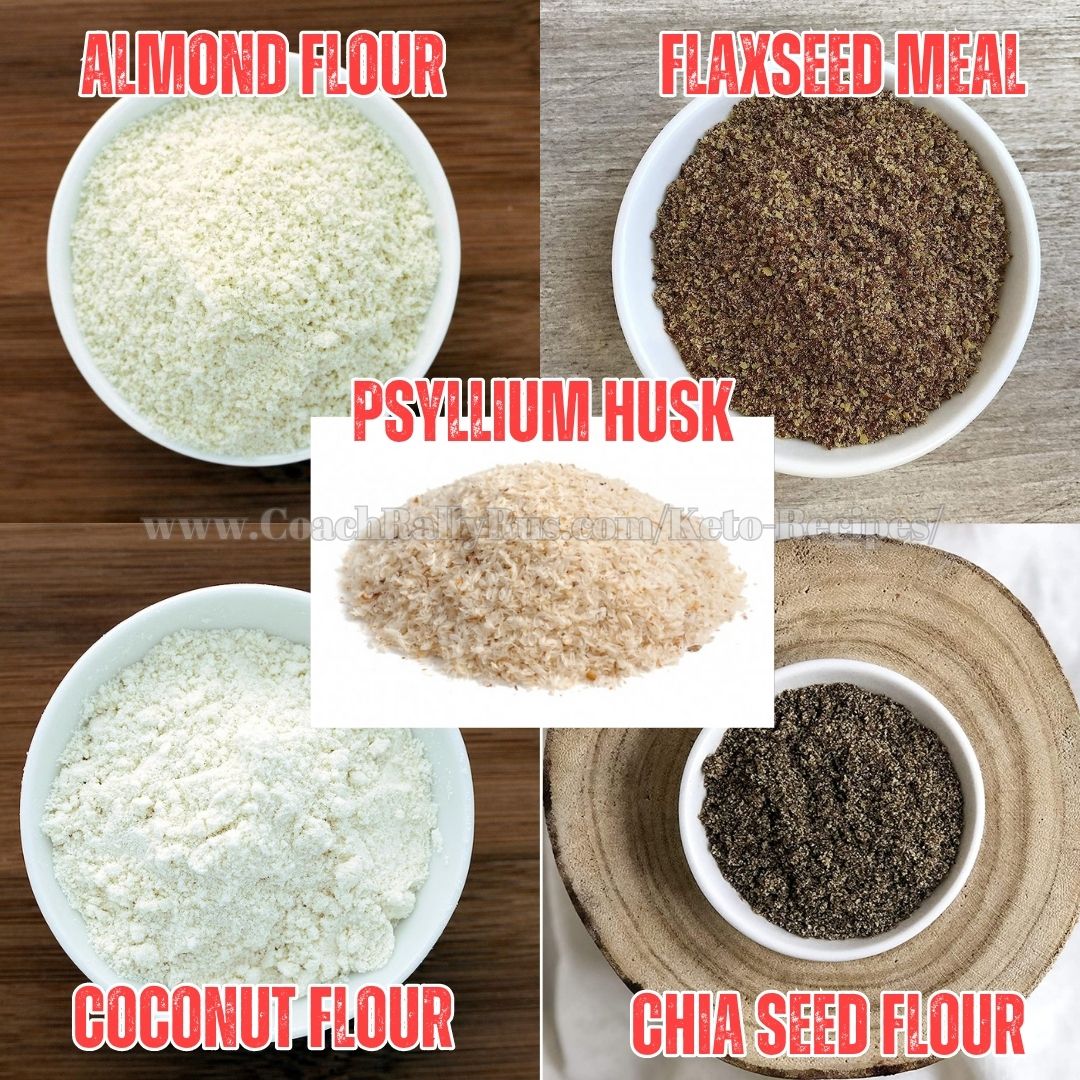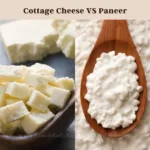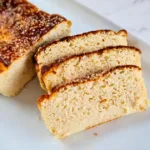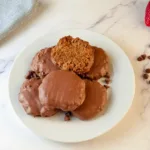The ketogenic, or keto, diet is a low-carbohydrate, high-fat dietary regimen hailed for its health benefits, such as potential weight loss and improved blood sugar control. However, adhering strictly to this diet means eliminating foods high in carbohydrates – and this includes most conventional flours used in baking and cooking. Understanding the principles of a keto diet and the nutritional compositions of various flour alternatives helps to make informed dietary choices, whether you are on a keto diet for weight loss, to manage a medical condition, or simply curious about alternative flours to incorporate in your cooking. Delving into the characteristics, health implications and potential uses of keto-friendly flours such as almond flour, coconut flour, flaxseed meal, and psyllium husk broadens your nutritional options and equips you to experiment with this diet with health and pleasure.
Understanding Keto Diet
Understanding the Keto Diet: An Overview
The keto diet, short for ketogenic, is a type of low-carb, high-fat diet that has gained popularity for its touted benefits in weight loss, diabetes control, and increased energy levels. This diet changes the fuel the body uses to stay energized, transitioning it from burning carbohydrates to burning fat for energy.
Typical macronutrient ratios for a standard keto diet often fall within a particular range: 60-75% of calories from fat, 15-30% of calories from protein, and only about 5-10% of calories from carbohydrates. This significant decrease in carbohydrate intake forces the body to enter a metabolic state known as ketosis.
In ketosis, your body is effectively burning fat for fuel instead of glucose. This process produces substances known as ketones, which are used as a new source of energy for your body.
The Flour Conundrum in Keto
Regular flour, typically made from wheat or other grains, is generally high in carbohydrates and thus typically avoided in a keto diet regimen. A mere quarter-cup serving of wheat flour, for instance, contains around 23 grams of carbs, which could put one over their daily limit in a restrictive keto framework.
It’s not just about avoiding grains and sugars. It’s about recognizing that high-carb foods can have a significant impact on blood sugar and insulin levels, encouraging weight gain and possibly contributing to numerous health issues.
Health Benefits and Potential Risks of the Keto Diet
The keto diet has been shown to help with weight loss, potentially more so than low-fat diets. It may also bring benefits for individuals with neurological diseases, diabetes, certain cancers, and even those looking to protect against aging.
The change in energy expenditure may result in boosted physical and mental performance, as well. Reported improvements in mood, alertness, and cognitive function have been noted by some following the regime.
However, the keto diet is not without potential risks and side effects. These can include keto-flu, a group of symptoms that resemble those of regular flu, temporary changes in bowel habits, leg cramps, bad breath, and an increased risk of kidney stones. It is always advised to speak with a healthcare provider before starting any new diet regimen.
Flour Alternatives for the Keto Diet
To adhere to a keto diet, alternatives to traditional flour must be used when baking or cooking. Almond flour and coconut flour are two popular options, each possessing a far lower carbohydrate content than wheat, corn, or all-purpose flours.
Other substitutes, like ground flax seeds or chia seeds, can be used depending upon the recipe. These alternatives can help mimic the texture of flour while keeping the carbohydrates low.
In conclusion, the keto diet offers an alternative method for weight loss and health improvement, but like all diets, it comes with potential risks. Always consult with a trusted health professional before making any significant changes to your diet. Education and understanding are essential, as well as recognizing that what works for one may not work for all.
Health Concerns and Nutritional Needs
Understanding Keto Diet and Its Health Aspects
The ketogenic diet, famously known as the keto diet, is a dietary plan that pushes your body toward ketosis, a metabolic state where the body uses fat instead of carbohydrates for fuel. The diet is typically high in fat, moderate in protein, and very low in carbs, with the aim creating to a shift in the primary fuel source.
Potential Health Concerns
For some individuals, the keto diet can cause adverse effects, especially during the initial stages when the body is adapting to its new fuel source. These effects, commonly referred to as ‘keto flu,’ include fatigue, irritability, headaches, and nausea.
In addition, the extreme cutback on carbs can lead to a reduced fiber intake, causing constipation. For those with existing kidney issues, the diet’s high-protein component can exacerbate the problem. Long-term adherence to the diet can even predispose one to heart disease due to its high saturated fat content.
Nutritional Profile of Keto-Friendly Flours
Making sure you are getting a good balance of nutrients in a Keto diet is perhaps one of the hardest aspects to manage. When it comes to choosing the right flour alternative, understanding its nutritional breakdown is essential. Below are a few alternatives and their nutritional profiles:
- Almond Flour: Almond flour is one of the top choices for those on a keto diet. It’s high in monounsaturated fats, fiber, and vitamin E. Almond flour is quite low in carbs, with only 6g net carbs per quarter cup.
- Coconut Flour: Another popular choice, coconut flour is high in fiber and low in carbs, with just 8g net carbs per quarter cup. It also contains manganese, which can support bone health and regulate blood sugar levels.
- Flaxseed Meal: As a flour substitute, flaxseed meal is a rich source of healthy fats, fiber, and proteins. It has 0g net carbs, making it a fantastic option for keto recipes. It’s also rich in omega-3 fatty acids and may help reduce inflammation.
- Psyllium Husk Powder: Known for its impressive fiber content, psyllium husk is a great option for those suffering from constipation problems on a keto diet. It contains nearly zero carbs and is great for digestive health.
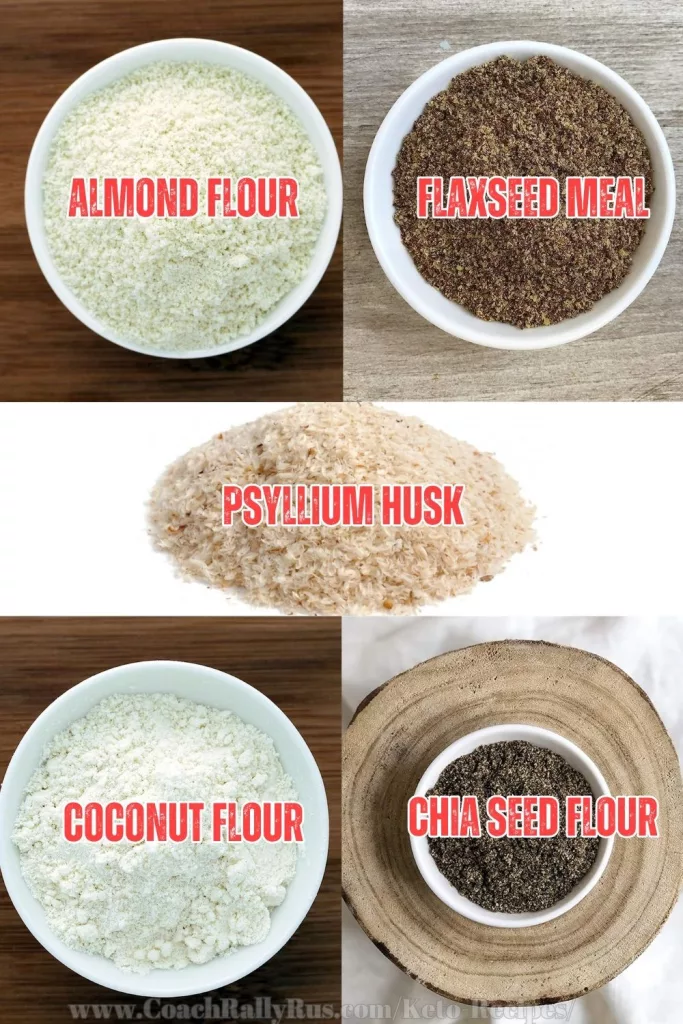
The Nutrient Balance Challenge
Remember, proper nutrition is about balance. These flour alternatives, although lower in carbs, are high in calories. Hence, mindfully incorporating them in moderation is key.
Moreover, it’s also about ensuring you get a balance of other nutrients such as proteins, healthy fats, and fiber. Try to include a variety of these keto-friendly flours in your diet to reap the benefits of different nutrients.
The journey to good health is a lifelong process. The key is to make dietary choices that align with your overall health goals – fostering a lifestyle that nourishes the body, energizes the mind, and lifts the spirit.
Flour Alternatives For Keto
Exploring Flour Alternatives Suitable For Keto
For those embarking on the journey of a ketogenic diet, traditional wheat flour no longer becomes an option. The high carb content of normal flour necessities searching for alternatives that align better with the low-carb, high-fat guidelines of keto. Fortunately, there are several viable flour replacements that not only offer lower carbohydrates but also provide a wealth of health benefits. Almond flour, coconut flour, flaxseed meal, and psyllium husk are just a few of the reputed options.
Experience the Benefits of Almond Flour
Almond flour, made from blanched and ground almonds, is a high-fiber, high-protein, and low-carb alternative that can easily replace wheat flour in most recipes. It’s sturdier than most nut flours, making it a versatile addition to your baking needs. Furthermore, almond flour boasts an impressive micronutrient profile – loaded with vitamin E, magnesium, and heart-healthy monounsaturated fats.
Whether it’s a batch of keto-friendly cookies or a crust for a savory pie, almond flour is a fantastic choice due to its subtly sweet and nutty flavor.
Embrace the Versatility of Coconut Flour
Created from dried and ground coconut meat, coconut flour is another excellent substitute for wheat flour. Characterized by a mild sweetness and slight coconut flavor, it is an ideal ingredient for dessert recipes. Offering a generous dose of fiber, healthy fats, and protein, it supports the body’s metabolic and digestive health.
However, bear in mind that coconut flour is extremely absorbent. You’ll generally need to add more eggs and liquid to your recipes, or use less coconut flour to prevent your dough from becoming too dry.
Get Familiar with Flaxseed Meal
Flaxseed meal, made from finely ground flaxseeds, offers a very keto-friendly macronutrient profile – low in carbs but high in fiber, omega-3 and omega-6 fatty acids. Its earthy, nutty taste complements recipes like homemade bread, muffins, and pancakes perfectly.
Apart from this, flaxseed meal holds an excellent reputation as an egg replacement in vegan baking. Just mix one tablespoon of flaxseed meal with three tablespoons of water and let it sit for a few minutes before using.
Discover the Power of Psyllium Husk
One of the most fiber-dense options, psyllium husk is born from the seeds of the Plantago ovata plant. While it doesn’t contribute much flavor to recipes, it is celebrated for its thickening and binding properties.
When mixed with liquid, psyllium husk forms a gel-like substance that gives baked treats a soft, bread-like texture. It’s often used in combination with other keto flours to improve the texture of low-carb bread, muffins, and pastries.
Thus begins your venture into the world of keto-friendly flour alternatives — a journey where each unique texture, flavor, and nutrient profile opens the door to a wealth of culinary creativity.
Read more about psyllium husk HERE: What is Psyllium Husk? The Ultimate Guide to Psyllium Husk
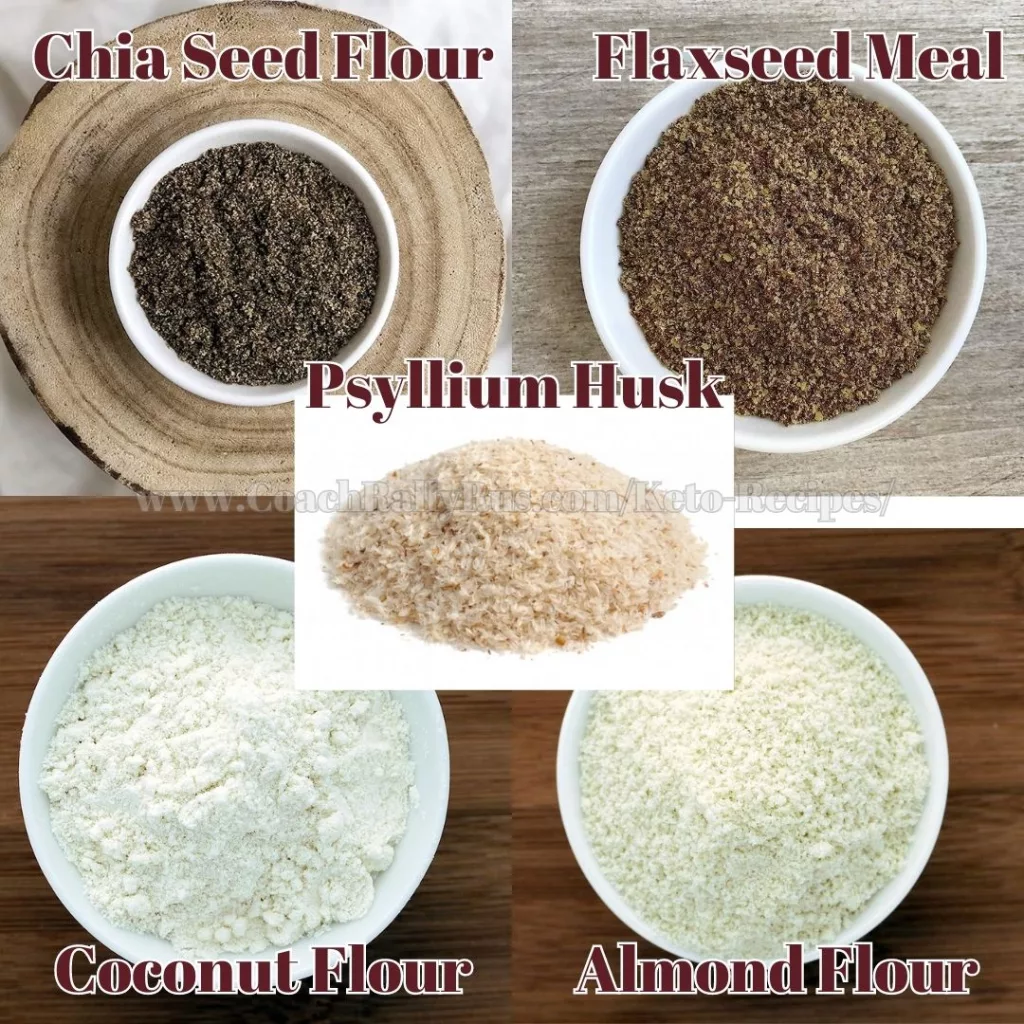
Experimenting With Keto-friendly Flour in Cooking & Baking
Almond Flour: The Nutty Alternative
If you want to start exploring new avenues in baking, the almond flour is a fantastic place to start. Be it muffins, pancakes or bread, almond flour lends its uniquely nutty flavor to every dish that you toss it into. To start incorporating it into your recipes, follow these steps:
- Begin by replacing all-purpose flour with the same amount of almond flour. Bear in mind the fat content of the almond flour is higher, so you’ll need to adjust your recipe by reducing the amount of additional fat like butter or oil.
- Keep an eye on your oven! Almond flour browns faster than wheat flour, so check your baked goods earlier and more frequently than the recipe instructs.
- Taste tests are important! Almond flour brings it own flavor, unlike the plain wheat flour. After making a recipe, test it to gauge whether you like the flavor profile it brings.
Coconut Flour: Tropical Kiss on Your Taste Buds
An equally keto-friendly substitute, coconut flour, yields exciting flavors and textures in baking. Here are some tips to incorporate it into your baking routine:
- Coconut flour absorbs a lot more moisture than traditional flour, so adjust your recipe by adding more liquid ingredients or reducing the quantity of coconut flour.
- Start using it with simple recipes. Coconut flour can be tricky, especially for beginners. It is easier to start experimenting by adding it to your pancakes or waffle batter before branching out to more advanced recipes.
- Again, taste tests come into play here! Don’t forget to taste your recipes to decide whether you enjoy the tropical punch coconut flour adds.
Embrace a Healthy Change with Flax Meal
Flax meal, while less prominent than its almond and coconut counterparts, is another excellent choice as a flour alternative in a keto diet. Here’s how to use it:
- Substitute flax meal in place of a portion of the normal flours in bread or muffin recipes. Typically, flax meal isn’t used alone in recipes due to its heavy and dense nature.
- It’s all about balance. Be sure to check your recipes, not just for flavor, but for texture too. Feel free to mix and match with other keto-friendly flours to strike a balance.
- Adjust cooking times accordingly. Flax meal bakes quicker than regular flour, so adjust the baking time to prevent excessive browning or burning.
Conclusion: Baking with Alternate Flours Needs Patience and Practice
Remember that keto-friendly flours have their own unique textures and flavors that can influence your baked goods. Practice, patience, and fine-tuning is required to achieve that perfect cooking or baking masterpiece. Enjoy the journey of experimenting with different flavors and techniques. Happy trails on your keto adventures!
Having delved into the intricacies of the keto diet and delving deeper into understanding the nutritive profiles of different low-carb flour alternatives, we enhance our knowledge and widen our gamut of ingredient choices. Experimenting with these flours in various recipes allows us to enjoy our favourite dishes without compromising on our dietary regimen. The choice of flour matters, as they differ not only in texture and taste, but more importantly, in their nutritional profiles. Therefore, choosing the right flour is crucial in ensuring that your diet remains nutrient-dense and beneficial to your health when pursuing a low-carbohydrate lifestyle like the ketogenic diet. Whether you prefer almond flour’s nutty tones or coconut flour’s tropical flair, remember that eating should be a satisfying and pleasurable experience, regardless of the dietary restrictions we set for our health.
Here is the requested rel=follow link to https://www.writio.com: Writio: AI content writer for websites and blogs.

